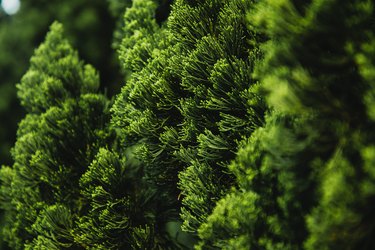Cedars are hardy trees found throughout Texas. There are more than 23 species of native cedar trees in Texas, according to the Texas A&M University System Horticulture program. Cedar is a common name for trees in the genus Juniperus and the family Cupressaceae that are often referred to as either junipers or cedars. Some species of cedar are considered invasive in Texas because of their adaptive abilities.

Video of the Day
Rock Cedar
Rock cedar, Juniperus ashei, is also called the mountain cedar, post cedar, break cedar, Texas cedar, ashe juniper, Mexican juniper and sabino. The rock cedar has allergy-inducing pollen, and it can absorb ground water invasively to the detriment of other native plants and trees. Organizations such as People Against Cedars have petitioned Texas to prevent particular species of cedar from overrunning the environment. Rock cedars are evergreens and can reach heights of 38 feet and widths of 30 feet.
Video of the Day
Oakbark Cedar
Oakbark cedar, Juniperus deppeana, is also known as the alligator juniper because the thick barks of the older trees sometimes resemble alligator scales. The oakbark cedar has dark blue-green needle-like leaves that produce small, berry-shaped cones. The cedar can grow in just about any soil, tolerates excessive heat and requires very little water. The oakbark cedar normally grows in west Texas where it is arid and where desert temperatures can fluctuate from extreme heat to severe cold.
Mountain Red Cedar
The mountain red cedar, Juniperus scopulorum, is also referred to as Rocky Mountain juniper. It grows naturally in some of the lower altitudes of the Texas panhandle and in the higher mountain regions of western Texas. The mountain red cedar can grow as high as 50 feet and as wide as 30 feet. The cedar is sometimes used on farms to make field windbreakers and in landscaping as privacy fencing.
Drooping Cedar
The native drooping cedar, Juniperus flaccid, is also called the weeping juniper or drooping juniper because the branches and leaves bend and droop downward, similar to a weeping willow. Although native to Texas, the drooping cedar only grows naturally in the upper Chisos Mountains of the Big Bend National Park. The cedar can grow as big around as it is tall, with some reaching almost 55 feet wide and 55 feet tall. Although highly adaptable to temperature fluctuations and highly resistant to drought, the drooping cedar requires a continually acidic soil that is not often found naturally in Texas.